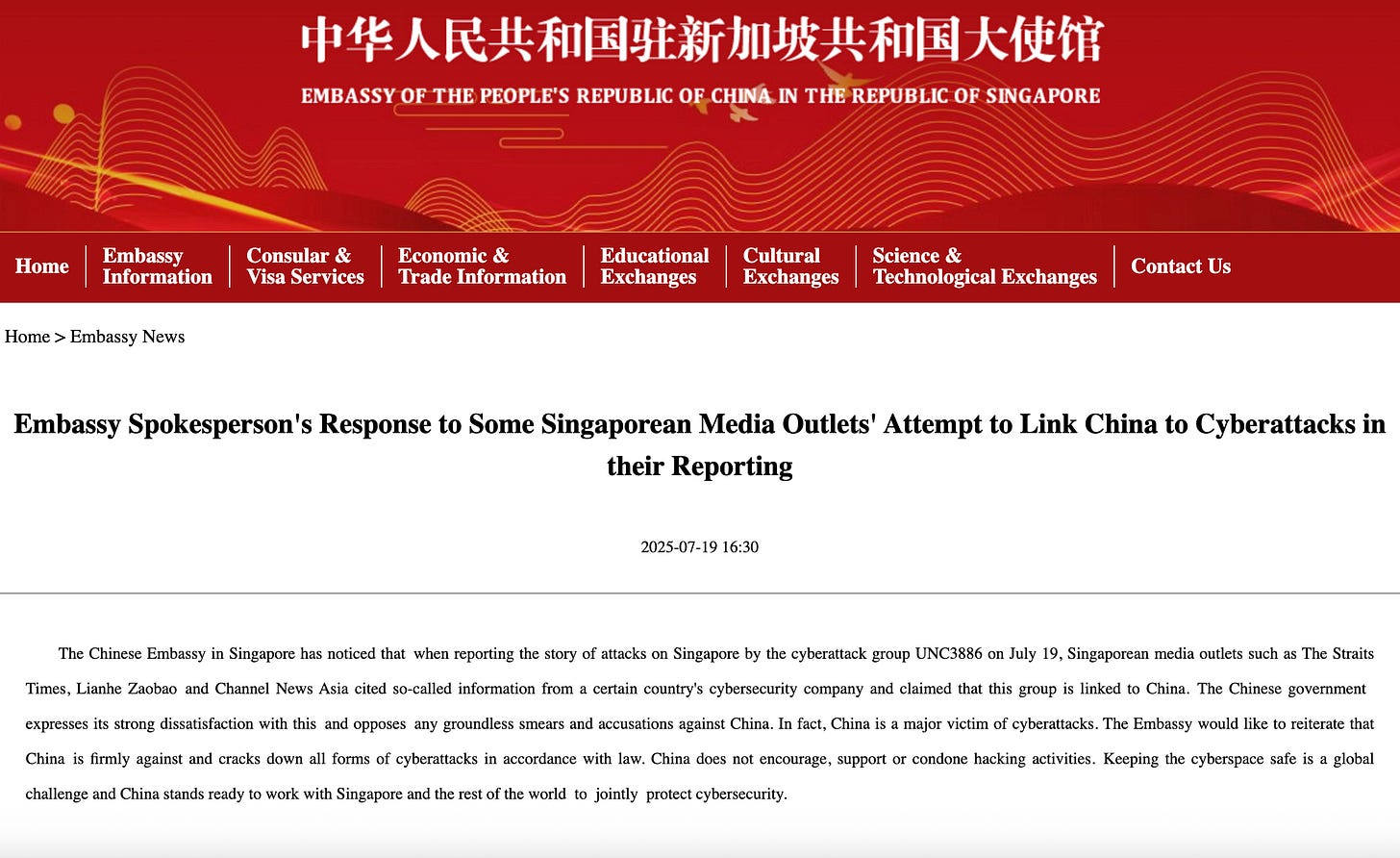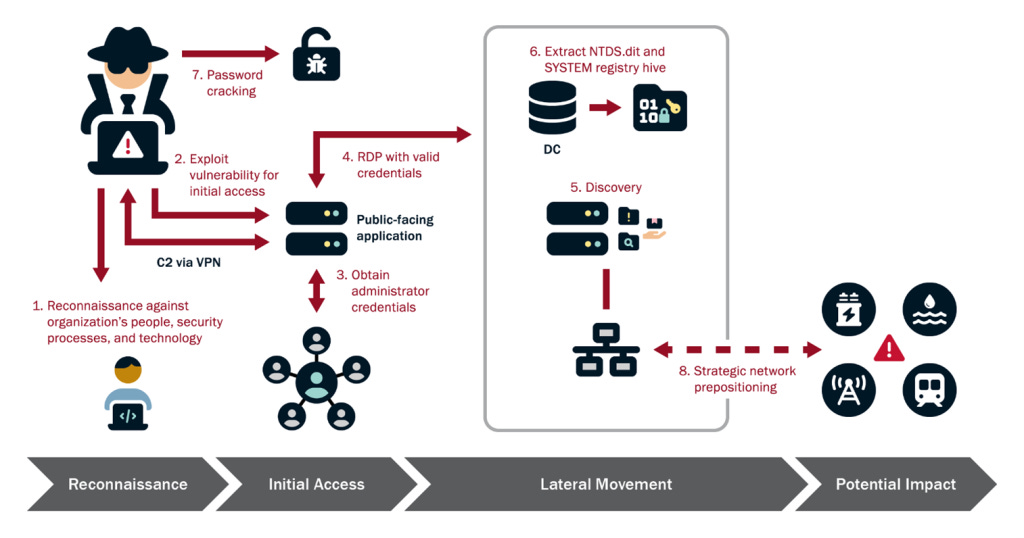Singapore Takes Unprecedented Military Action Against Chinese State-Sponsored Hackers
UNC3886 attack on Singapore's critical infrastructure highlights the growing Chinese cyber threat to US allies and partners in the Indo-Pacific
Singapore's critical infrastructure is currently under attack by UNC3886, a sophisticated cyber espionage group affiliated with the Chinese state. This situation report discusses the unusually forceful response that the Singaporean government has launched, the broader strategic context, and what it says about the growing threat of Chinese cyber attacks for the US and its Indo-Pacific allies and partners.
OVERVIEW:
The exact nature of the ongoing cyber attack in Singapore has not been disclosed, other than that the hackers targeted the country’s critical infrastructure. The country’s response over the last week indicates that the attack is unusually severe.
On July 18, Singapore’s Coordinating Minister for National Security K. Shanmugam announced that the government was responding to an attack by an advanced persistent threat actor (APT) on its critical infrastructure. Shanmugam then took the unusual step of attributing the attacks to a group known as UNC3886. The naming of UNC3886 was a significant public declaration because the group is widely believed to be affiliated with the Chinese state. Previously, Singapore avoided directly linking cyberattacks to Chinese-affiliated groups, including when Singtel, its top telecom company, was targeted in 2024.
While Singapore did not explicitly state China’s involvement, the Chinese government nevertheless vehemently denied all responsibility for the attack. Statements by the Chinese Embassy to Singapore called attempts by the media to link UNC3886 to China were smears against a country who itself “is a major victim of cyber attacks.”

A day later, Singapore’s Minister of Defence Chan Chun Sing announced that the country’s response to the attacks had escalated to include the Singapore Armed Forces (SAF) and Ministry of Defence (MINDEF) as part of a “whole of government” effort to uproot the attackers from the country’s networks.
BIGGER PICTURE:
Singapore’s Cyber Security Act classifies the following 11 sectors of its economy as critical infrastructure: “Energy, Water, Banking & Finance, Healthcare, Transport (which includes Land, Maritime, and Aviation), Government, Infocomm, Media, and Security & Emergency Services.”
This is not the first time one of the 11 sectors of Singapore’s critical infrastructure has come under attack. A particularly bad attack in 2018 targeted Singapore’s largest healthcare provider SingHealth, stealing the medical records from 1.5 million Singaporeans, including those of the Prime Minister Lee Hsien Loong and other members of Parliament.
The response to this attack has been unusually forceful compared with previous incidents, such as SingHealth which had been criticized as slow and disorganized. This suggests either a new approach by the government or an unusually significant threat. Recent patterns of attacks by Chinese-state affiliated groups raise questions as to whether the Singapore Armed Force and Ministry of Defence were called in to support a whole of government response, or whether the country’s Security and Emergency Services infrastructure was itself a target of the attack.
UNC3886 Operations in Context
A July 2023 report by Google’s Mandiant cybersecurity firm identified UNC3886 as a top Chinese cyber espionage group. The group has targeted top firms in the defense, technology and telecommunications industries in the US and across Asia using complex and stealthy attacks to conduct long-term surveillance.
Mandiant researchers allege that UNC3886 has demonstrated an ability to penetrate tightly secured networks, entering through network edge devices such as routers, using multiple Zero-Day exploits.1 Once inside, UNC3886 goes to great lengths to retain a long-term presence in its victim’s systems, using custom malware to circumvent security controls and modify system logs.
UNC3886 is one of many Chinese cyber espionage groups, which Mandiant alleges have become significantly more sophisticated over the last decade due to a restructuring of China’s national security apparatus which more deeply integrates cyber capabilities:
“We suggest that the military and intelligence restructure, evidence of shared development and logistics infrastructure, and legal and institutional structures directing vulnerability research through government authorities point to long term investments in equipping Chinese cyber operators with more sophisticated tactics, tools, and exploits to achieve higher success rates in gaining and maintaining access to high value networks.”
Escalating Threat of Chinese Cyberattacks to US and Indo-Pacific Allies
The effects of this restructuring are clearly visible in the number of recorded attacks by Chinese state-affiliated groups. Cybersecurity firm CrowdStrike has reported that attacks by Chinese affiliated cyber espionage groups increased over 150% year-on-year in 2024. Many of the most high profile targets of Chinese state cyber attacks have been the US as well as its allies in the Indo-Pacific.
Other Notable Chinese State-affiliated Groups and Cyber Campaigns
Salt Typhoon
Salt Typhoon (aka UNC2286) conducted one of the largest cyber espionage operations in history. In October 2024, it was publicly reported that the group hacked into at least nine US telecom corporations including Verizon, AT&T, T-Mobile, Spectrum, Lumen, and Viastat. Salt Typhoon attempted to collect massive amounts of user data from the company networks, including from both the Trump and Harris Presidential Campaigns.
The group used access to these corporations as a springboard for hacks into wider government systems. The hackers were able to access wire taps and other electronic intercepts used by law enforcement and the intelligence community. A June 2025 memo issued by the Department of Homeland Security confirmed the group was able to gain access to networks used by at least one state’s Army National Guard. More recent reporting by Bloomberg on July 22, suggested the group breached the servers of Department of Energy’s National Nuclear Security Agency.
Flax Typhoon
Since 2021, the Integrity Technology Group, Incorporated (aka Flax Typhoon), a Beijing-based cybersecurity firm has targeted critical infrastructure across the US, Europe, and Asia. While several US firms have been targeted by Flax Typhoon, most of the group’s operations have focused on Taiwanese organizations, including electronics manufacturers, universities and government institutions.
The group’s global operations, consisting of over 200,000 bot nets, were disrupted by an FBI operation in the summer of 2024.
Linen Typhoon, Violet Typhoon, Storm-2603
On July 22, as Singapore battled to remove UNC3886 from its digital infrastructure, Microsoft’s Security Response Center announced that it had concluded that two Chinese hacker groups, Linen Typhoon and Violet Typhoon, were responsible for massive infiltration of its SharePoint systems in a series of months-long attacks. Linen Typhoon is a known cyber theft group which steals intellectual property from government, defense and human rights organizations in opportunistic attacks. Violet Typhoon is a cyber espionage group that, according to Microsoft, embeds itself in systems to conduct long-term surveillance of political and social elites across the US, Europe, and East Asia.
Another Chinese cyber crime group, Storm-2603, is believed to have also attempted to exploit the vulnerabilities created by the Typhoon groups.
Volt Typhoon (aka UNC3236)
Volt Typhoon is a Chinese cyber warfare group which infiltrates critical infrastructure systems to create a long-term presence that may be used to compromise operational technology (OT). A February 2024 advisory by the US Cybersecurity and Infrastructure Agency (CISA) described the group’s activities:
“The U.S. authoring agencies have confirmed that Volt Typhoon has compromised the IT environments of multiple critical infrastructure organizations—primarily in Communications, Energy, Transportation Systems, and Water and Wastewater Systems Sectors—in the continental and non-continental United States and its territories, including Guam. Volt Typhoon’s choice of targets and pattern of behavior is not consistent with traditional cyber espionage or intelligence gathering operations, and the U.S. authoring agencies assess with high confidence that Volt Typhoon actors are pre-positioning themselves on IT networks to enable lateral movement to OT assets to disrupt functions.”

In addition to targeting US critical infrastructure, the group also targeted Singtel Singapore’s largest telecom operator, and parent company to Australia’s second largest telecom provider.
IMPLICATIONS:
While the information about the current attack is limited, several factors can be inferred about why Chinese groups targeted Singapore and why Singapore may have responded in the way it did.
China is Linking Cyber Attacks to Support for Taiwan
The Wall Street Journal reported on April 10, 2025, that Chinese officials allegedly told US counterparts in December that China's years-long cyber attacks on American critical infrastructure were conducted in response to US support for Taiwan.
Singapore has long tried to conduct a diplomatic balancing act over the Taiwan issue. The country maintains a “One China Policy” but has robust trade and military relations with Taiwan. Singapore has conducted joint military training with Taiwan since 1975 under “Project Starlight.” The countries signed a new Agreement on Defense Exchanges and Security Cooperation in 2019, which has been the focus of Beijing’s ire. Singapore is also a key partner supporting US naval operations in the Indo-Pacific aimed at deterring a Chinese invasion.
Chinese attacks may be designed to develop leverage that deters Singapore from taking a more active role in US strategy.
Threat Posed by Chinese Cyber Groups Worsening
Singapore’s robust response, which both calls out China and incorporates the military into its cyber operations, is likely Singapore’s own attempt to deter worsening attacks in the future. Singapore’s Coordinating Minister for National Security K. Shanmugam says that the number of advanced persistent threat attacks on the country has quadrupled between 2021 and 2024. As discussed above, attacks by Chinese cyber groups are not only increasing in frequency but also escalating in severity, evolving from traditional theft and surveillance operations to targeting critical infrastructure.
It is not certain, but plausible that the involvement of Singapore's military may not have been a strategic escalation but rather a protective measure, designed to prevent the kind of cascading breach that allowed Chinese Salt Typhoon hackers to use compromised telecom companies’ networks to access systems used by US Army National Guard and National Nuclear Security Administration. It is also plausible that the attack was severe and complex enough to require the support of Singapore’s military to respond effectively.
“Zero-days” are vulnerabilities unknown to security teams giving developers “0” days to fix them. Zero-day threats tend to be especially dangerous as they can be difficult to detect until an attacker is wreaking havoc within a system.




